Pressure Washing Draper
Find Commercial Pressure Washing in Draper
Receive multiple Deck and Fence Cleaning quotes for your project today! Compare profiles, reviews, accreditations, portfolio, etc... and choose the best deal.
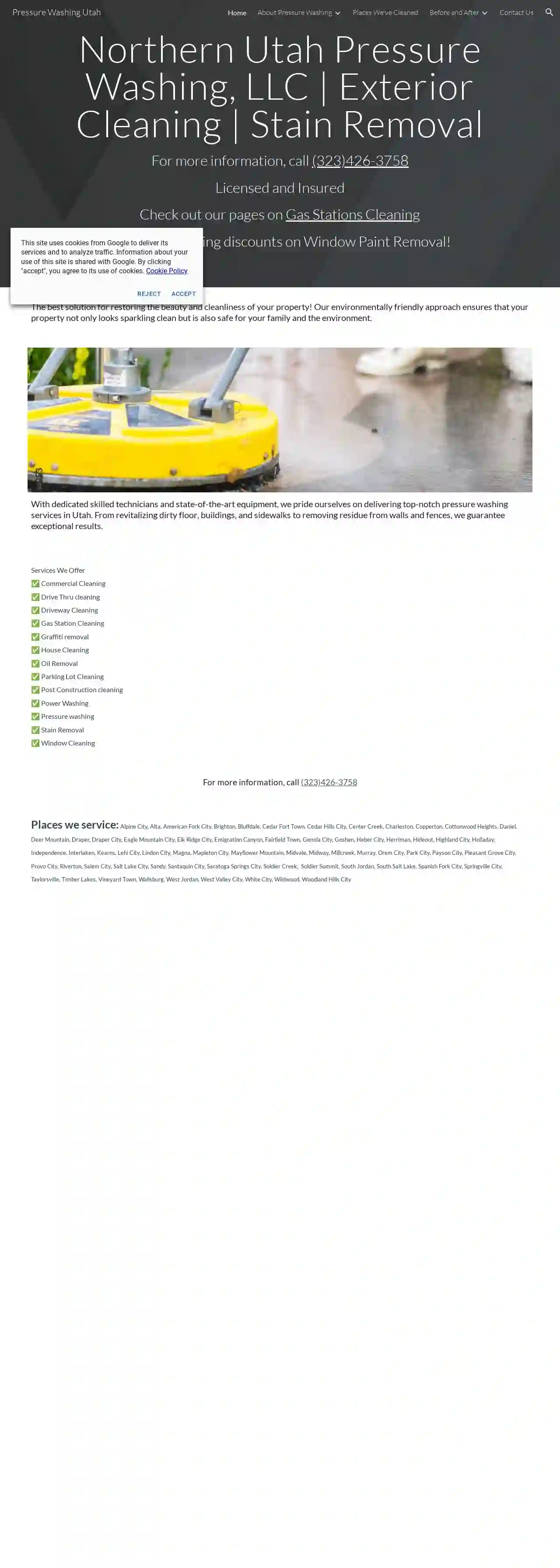
Northern Utah Pressure Washing
53 reviewsProvo, USNorthern Utah Pressure Washing, LLC is Utah's best option for commercial & residential pressure washing. Pressure washing is a top investment for your property. Clean and revitalize surfaces without costly renovations. Protect your exterior from damage caused by grime, mold, and mildew. Enhance curb appeal and extend the life of your surfaces with professional pressure washing services.
- Services
- Why Us?
- Gallery
Get Quote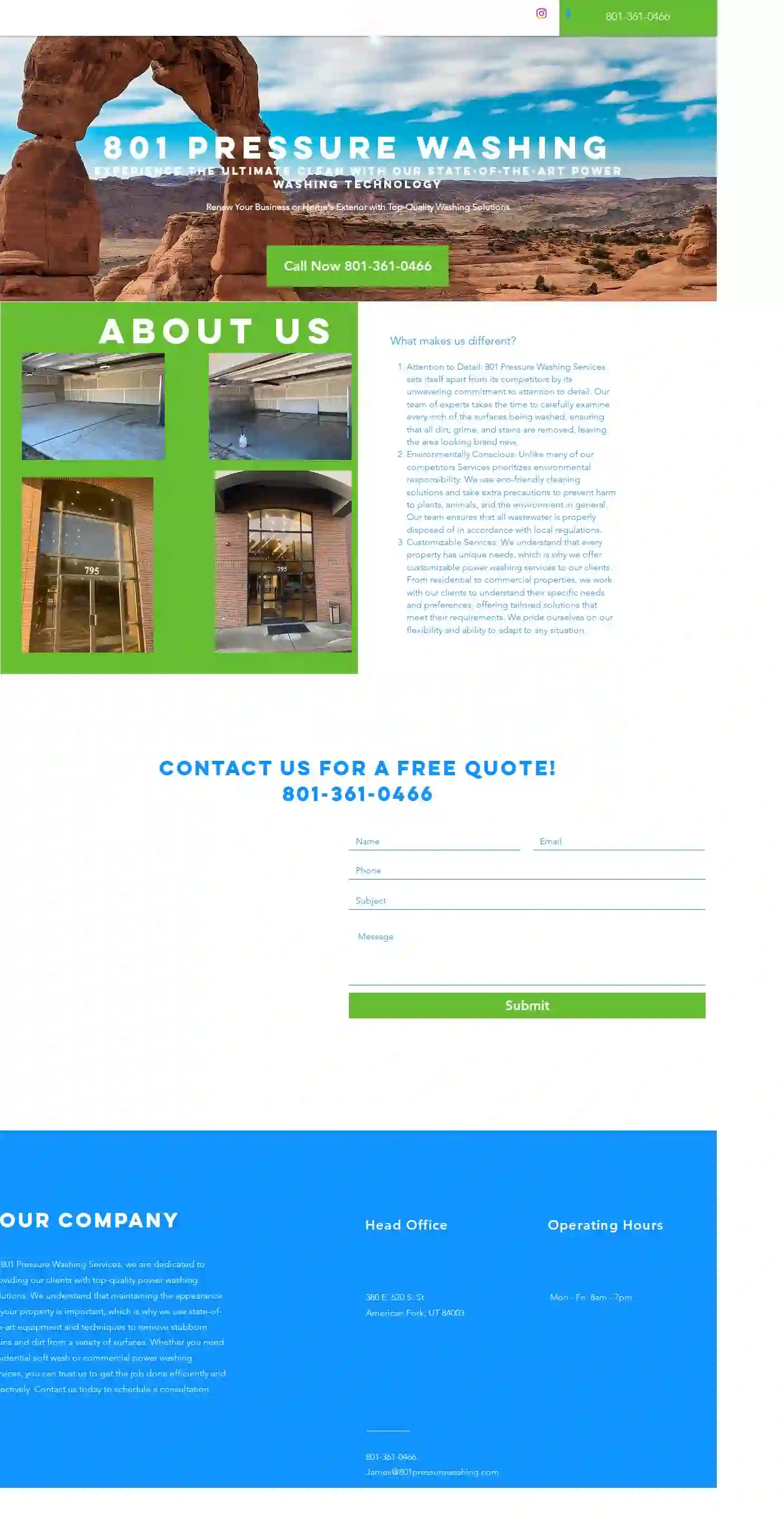
801 Pressure Washing
380 E. 620 S. St, American Fork, 84003, US801 Pressure Washing Services is dedicated to providing top-quality power washing solutions for both residential and commercial properties. We understand the importance of maintaining your property's appearance and utilize state-of-the-art equipment and techniques to effectively remove stubborn stains and dirt from a variety of surfaces. Our commitment to excellence sets us apart. We prioritize attention to detail, ensuring every inch is meticulously cleaned. We are also environmentally conscious, using eco-friendly cleaning solutions and responsible disposal practices. We believe in offering customizable services to meet each client's unique needs. Whether you require residential soft wash or commercial power washing, our team is here to deliver efficient and effective results. Contact us today to schedule a consultation and experience the ultimate clean!
- Services
- Why Us?
- Our Team
- Gallery
Get Quote
Mountain West Pressure Washing
513 reviewsVineyard, UT, 123 Main St, 84059, USMountain West Pressure Washing is a Provo-based company that specializes in high-density housing and building washing services. Their goal is to improve the Provo community through their commercial pressure washing services. They understand the fact that they are in the service industry, and their team takes pride in this simple truth. Through the commercial pressure washing services they provide, they work their hardest to boost the business efforts of their clients. They are honored by the trust that their customers show in their skills and services. They honor that trust by providing the best pressure washing services in return.
- Services
- Why Us?
- Accreditations
- Our Team
- Testimonials
- Gallery
Get Quote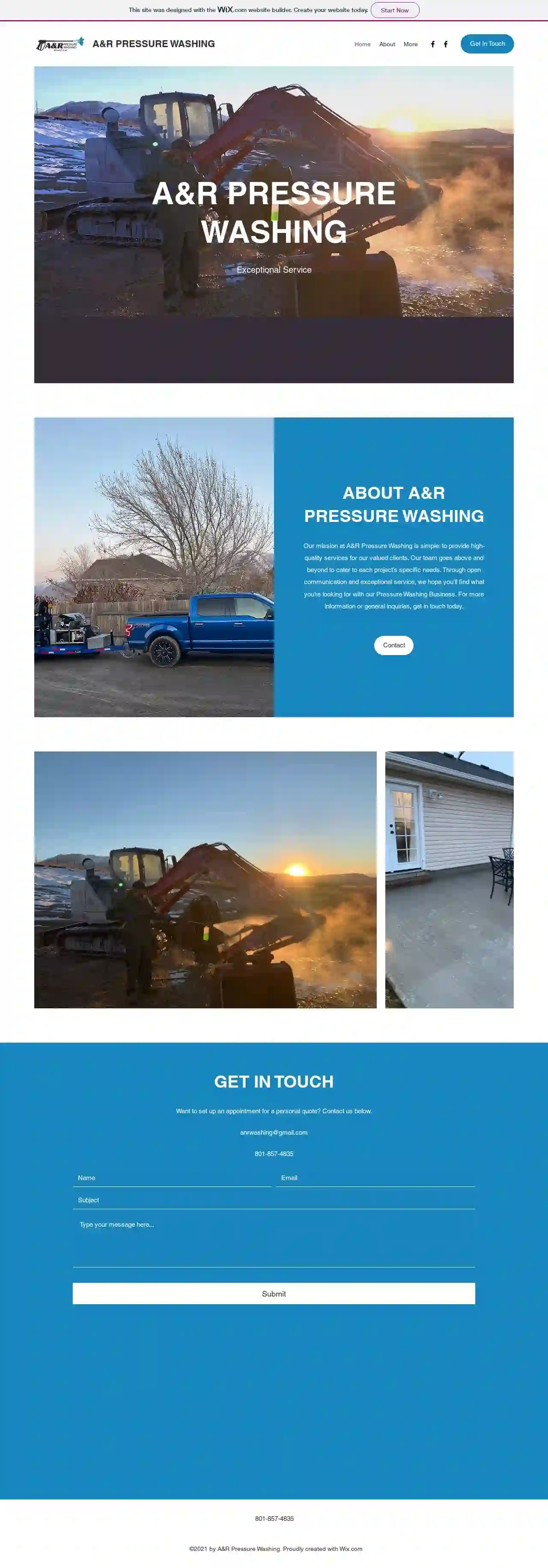
A&R Pressure Washing
54 reviewsProvo, USOur mission at A&R Pressure Washing is simple: to provide high-quality services for our valued clients. Our team goes above and beyond to cater to each project’s specific needs. Through open communication and exceptional service, we hope you’ll find what you’re looking for with our Pressure Washing Business. For more information or general inquiries, get in touch today.
- Services
- Why Us?
- Gallery
Get Quote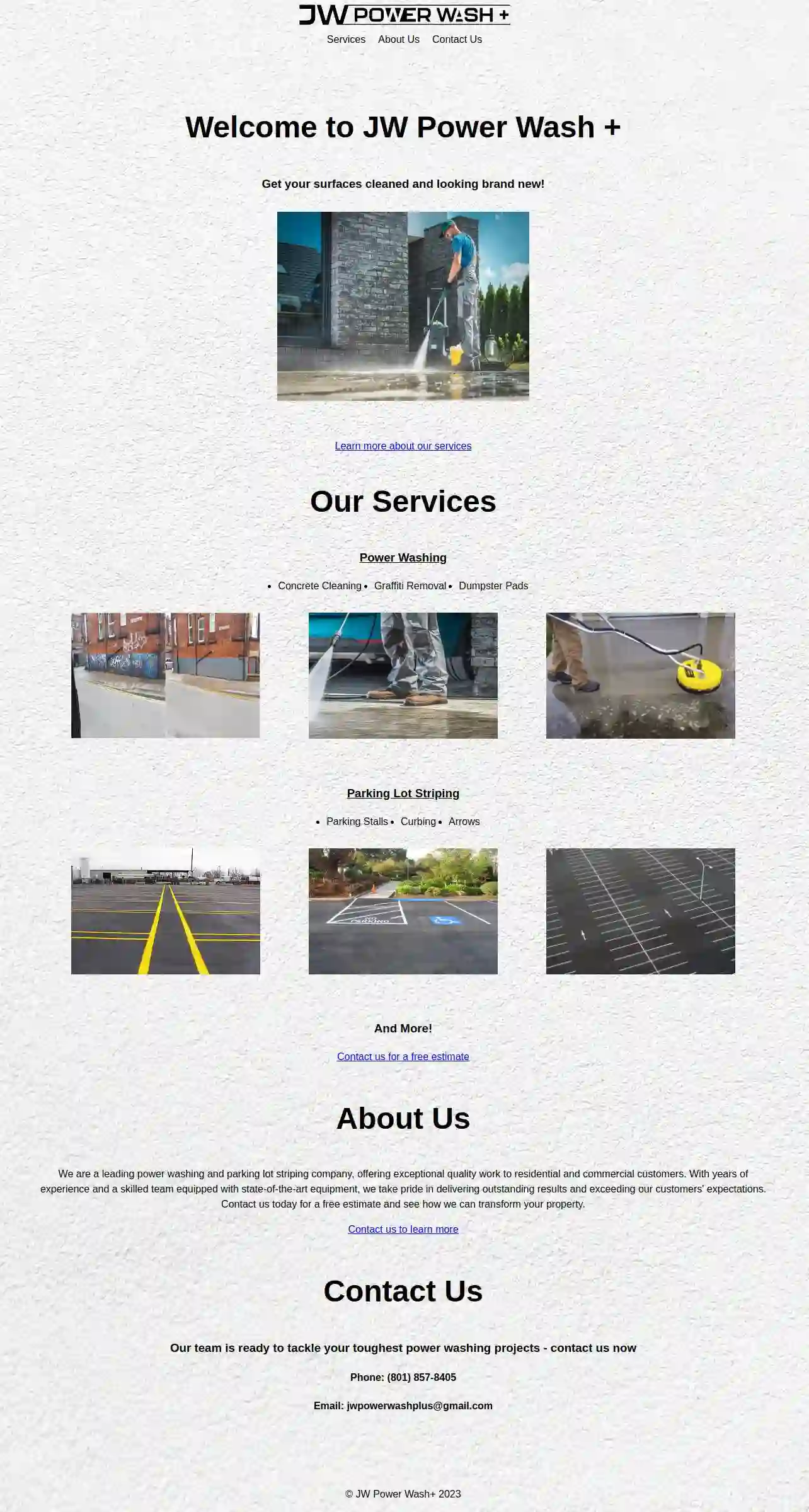
JW Power Wash Plus
53 reviewsProvo, USJW Power Wash+ is a leading power washing and parking lot striping company dedicated to providing exceptional quality work to both residential and commercial clients. With years of experience and a skilled team utilizing state-of-the-art equipment, we pride ourselves on delivering outstanding results and exceeding customer expectations. Contact us today for a free estimate and discover how we can transform your property.
- Services
- Why Us?
- Gallery
Get Quote
AquaPro
5102 reviewsPleasant Grove, UT, AquaPro Company, 84062, USExperience why your neighbors in and around Salt Lake City choose AquaPro for all their window cleaning and exterior cleaning needs. Your home is one of the biggest investments that you will make. It’s important that you feel proud of it. Whether your windows are streaky, your home siding is dirty or your driveway is stained, all of these things impact how you feel about your home. At AquaPro, we are here to help ensure that you feel proud of your property. We provide professional window cleaning, house washing, gutter cleaning and more so that you not only feel proud as you pull up on your driveway, but you can spend time doing things with those that matter most.
- Services
- Why Us?
- Testimonials
- Gallery
Get Quote
Rinse Cleaning
4.9306 reviews123 Main Street, San Diego, 92101, USRinsecleaning is a family owned and operated business serving the greater San Diego area. We are committed to providing our clients with the highest quality cleaning services at competitive prices. Our team of experienced and professional cleaners is dedicated to exceeding your expectations. We offer a wide range of services, including residential and commercial cleaning, as well as specialized services such as carpet cleaning and window cleaning. We use only the best cleaning products and equipment to ensure that your home or business is sparkling clean. We are fully insured and bonded, so you can rest assured that your property is in good hands. We are committed to providing our clients with exceptional service and value. Contact us today for a free estimate.
- Services
- Why Us?
Get Quote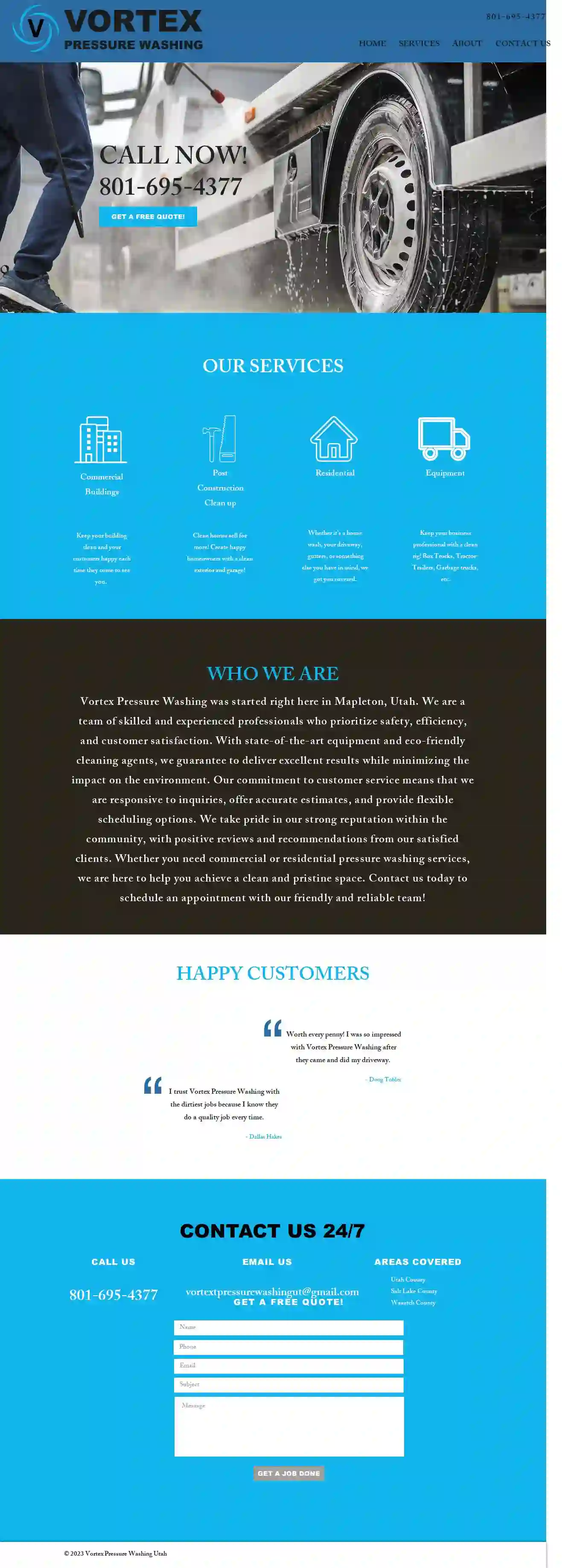
Vortex Pressure Washing
511 reviewsProvo, USVortex Pressure Washing was started right here in Mapleton, Utah. We are a team of skilled and experienced professionals who prioritize safety, efficiency, and customer satisfaction. With state-of-the-art equipment and eco-friendly cleaning agents, we guarantee to deliver excellent results while minimizing the impact on the environment. Our commitment to customer service means that we are responsive to inquiries, offer accurate estimates, and provide flexible scheduling options. We take pride in our strong reputation within the community, with positive reviews and recommendations from our satisfied clients. Whether you need commercial or residential pressure washing services, we are here to help you achieve a clean and pristine space. Contact us today to schedule an appointment with our friendly and reliable team!
- Services
- Why Us?
- Testimonials
- Gallery
Get Quote
Faber Curb Appeal
53 reviewsProvo, USFaber Curb Appeal is a locally-owned and family-operated garbage can cleaning business serving Utah County. We believe a well-maintained lawn is a reflection of pride in your home or business. Our passion for creating lush, vibrant landscapes has made us a leading lawn maintenance company. We specialize in a range of services, including lawn maintenance, pressure washing, landscaping, and sprinkler repair. We are dedicated to excellence and transforming your outdoor space into a masterpiece. Our services include mowing, edging, trimming, fertilization, weed control, and aeration. We also offer professional pressure washing services for driveways, walkways, decks, patios, siding, roofs, and more. Our landscaping experts can design and implement a landscape that suits your preferences and enhances your property's beauty. We also provide sprinkler repair and maintenance services to ensure your system operates efficiently. We are committed to customer satisfaction and offer professional-grade lawn maintenance services, including snow plowing, snow removal, window cleaning, aerating, tree removal, and more. Our innovative work and reasonable pricing keep our customers coming back.
- Services
- Why Us?
- Gallery
Get Quote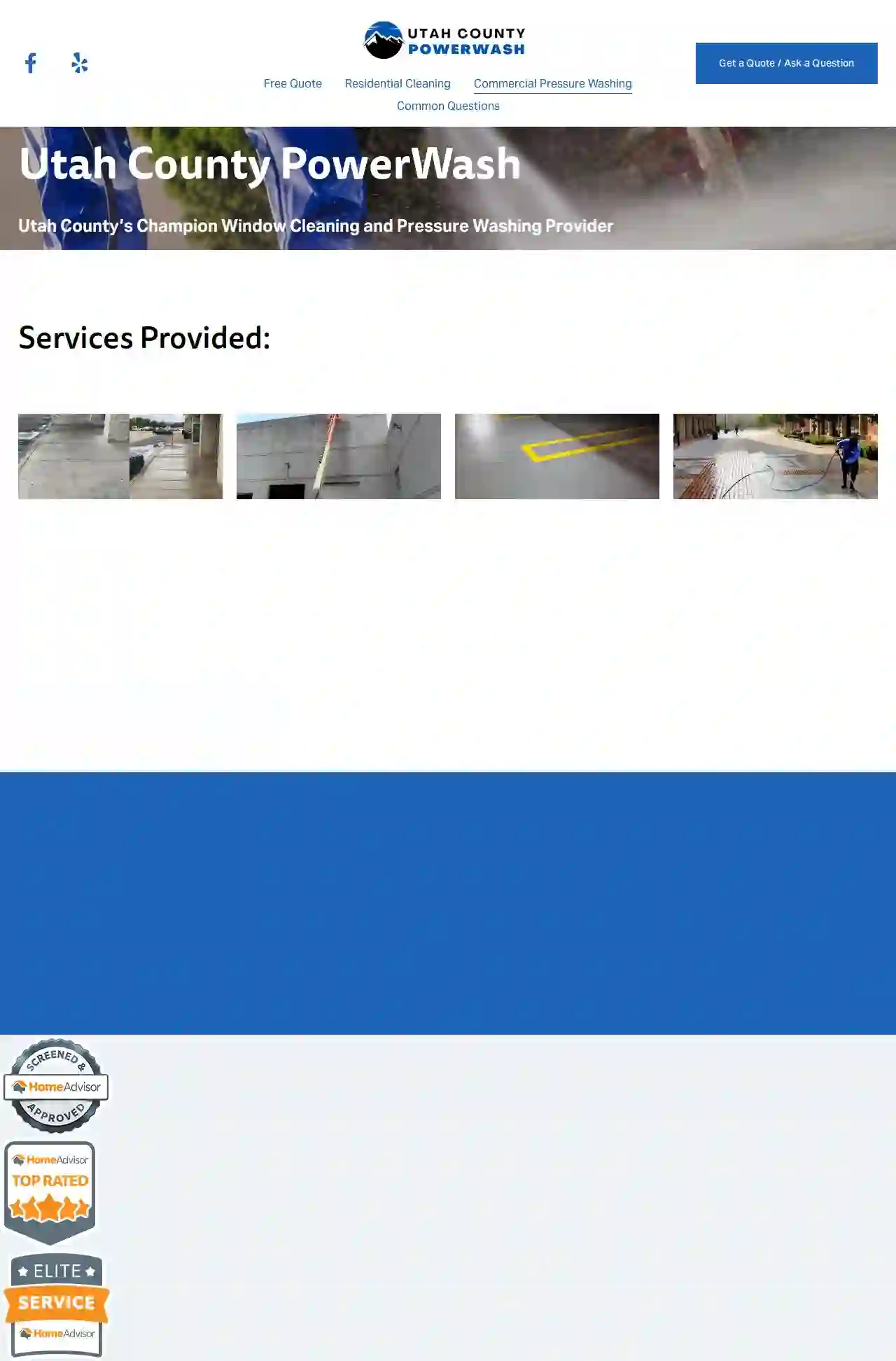
Utah County PowerWash
57 reviewsProvo, USUtah County PowerWash is Utah County’s Champion Window Cleaning and Pressure Washing Provider. We offer a variety of services to keep your property looking its best, including concrete sidewalk and walkway cleaning, building siding cleaning, parking lot and oil removal, and public area cleaning. Our team is experienced and professional, and we are committed to providing our customers with the highest quality service. Services Provided: Concrete Sidewalk and Walkways Building Siding Parking Lots and Oil Removal Public Area Cleaning Click Here For Booking/Free Quote
- Services
- Why Us?
- Gallery
Get Quote
Over 60,241+ Janitorial Companies in our network
Our janitorial pros operate in Draper & beyond!
CleaningMatch has curated and vetted Top Janitorial Companies arround Draper. Find a top & trustworthy pro today.
Frequently Asked Questions About Pressure Washing
- 0-degree Nozzle: Produces a highly concentrated, powerful jet of water for removing stubborn stains or stripping paint. Use with caution as it can damage surfaces easily.
- 15-degree Nozzle: A versatile nozzle for cleaning concrete, brick, and other hard surfaces. Provides a good balance of pressure and coverage.
- 25-degree Nozzle: A wider spray pattern for cleaning delicate surfaces like siding or fences.
- 40-degree Nozzle: A very wide spray pattern, ideal for rinsing or applying cleaning solutions.
- Soap Nozzle: A low-pressure nozzle designed specifically for applying cleaning solutions.
- Rotary Nozzle: Also known as a turbo nozzle, it produces a rotating, high-impact spray for tackling tough stains and grime.
- Online Reviews: Check online reviews on platforms like Google, Yelp, and Facebook to gauge customer satisfaction and service quality.
- Experience and Expertise: Look for companies with a proven track record and experience in pressure washing various surfaces.
- Licensing and Insurance: Ensure the company is licensed and insured to protect you from liability in case of accidents or damage.
- Equipment and Techniques: Inquire about the company's equipment and techniques to ensure they use appropriate pressure levels and cleaning solutions for different surfaces.
- Quotes and Pricing: Obtain detailed quotes from multiple pressure washing companies and compare their pricing. Make sure the quotes are transparent, outlining all services and costs.
- Professionalism and Communication: Choose a company that is responsive, provides clear communication, and demonstrates professionalism in its interactions.
- Pressure Washing: Suitable for hard surfaces like concrete, brick, stone, and decks that can withstand high pressure. Effective for removing stubborn dirt, grime, and stains.
- Soft Washing: Best for delicate surfaces like roofs, siding, painted surfaces, and wood fences that may be damaged by high pressure. Effective for removing mold, mildew, algae, and other contaminants without causing harm.
- Size of the Area: Larger areas generally cost more to pressure wash than smaller ones.
- Type of Surface: Different surfaces require different pressure levels and cleaning solutions, which can affect pricing.
- Condition of the Surface: Heavily soiled or stained surfaces may require more time and effort to clean, impacting cost.
- Accessibility: Difficult-to-reach areas may require specialized equipment and increase costs.
- Additional Services: Services like pre-treating stains, applying protective coatings, or mold removal may incur additional charges.
What are the different types of pressure washer nozzles?
Choose the appropriate nozzle based on the cleaning task and the type of surface being cleaned. Consult the pressure washer manual or a professional pressure washer for guidance.
How do I find a good pressure washing service?
Utilize online directories like CleaningMatch to find and compare qualified pressure washing services in your area.
How do I know if I need pressure washing or soft washing?
If you're unsure which method is best for your surfaces, consult with a professional pressure washing company. They can assess your needs and recommend the most appropriate cleaning method.
How much does pressure washing cost?
To get accurate pricing, request quotes from multiple pressure washing companies. Provide details about the size and type of surface, its condition, and any additional services you require.
What are the different types of pressure washer nozzles?
- 0-degree Nozzle: Produces a highly concentrated, powerful jet of water for removing stubborn stains or stripping paint. Use with caution as it can damage surfaces easily.
- 15-degree Nozzle: A versatile nozzle for cleaning concrete, brick, and other hard surfaces. Provides a good balance of pressure and coverage.
- 25-degree Nozzle: A wider spray pattern for cleaning delicate surfaces like siding or fences.
- 40-degree Nozzle: A very wide spray pattern, ideal for rinsing or applying cleaning solutions.
- Soap Nozzle: A low-pressure nozzle designed specifically for applying cleaning solutions.
- Rotary Nozzle: Also known as a turbo nozzle, it produces a rotating, high-impact spray for tackling tough stains and grime.
Choose the appropriate nozzle based on the cleaning task and the type of surface being cleaned. Consult the pressure washer manual or a professional pressure washer for guidance.
How do I find a good pressure washing service?
- Online Reviews: Check online reviews on platforms like Google, Yelp, and Facebook to gauge customer satisfaction and service quality.
- Experience and Expertise: Look for companies with a proven track record and experience in pressure washing various surfaces.
- Licensing and Insurance: Ensure the company is licensed and insured to protect you from liability in case of accidents or damage.
- Equipment and Techniques: Inquire about the company's equipment and techniques to ensure they use appropriate pressure levels and cleaning solutions for different surfaces.
- Quotes and Pricing: Obtain detailed quotes from multiple pressure washing companies and compare their pricing. Make sure the quotes are transparent, outlining all services and costs.
- Professionalism and Communication: Choose a company that is responsive, provides clear communication, and demonstrates professionalism in its interactions.
Utilize online directories like CleaningMatch to find and compare qualified pressure washing services in your area.
How do I know if I need pressure washing or soft washing?
- Pressure Washing: Suitable for hard surfaces like concrete, brick, stone, and decks that can withstand high pressure. Effective for removing stubborn dirt, grime, and stains.
- Soft Washing: Best for delicate surfaces like roofs, siding, painted surfaces, and wood fences that may be damaged by high pressure. Effective for removing mold, mildew, algae, and other contaminants without causing harm.
If you're unsure which method is best for your surfaces, consult with a professional pressure washing company. They can assess your needs and recommend the most appropriate cleaning method.
How much does pressure washing cost?
- Size of the Area: Larger areas generally cost more to pressure wash than smaller ones.
- Type of Surface: Different surfaces require different pressure levels and cleaning solutions, which can affect pricing.
- Condition of the Surface: Heavily soiled or stained surfaces may require more time and effort to clean, impacting cost.
- Accessibility: Difficult-to-reach areas may require specialized equipment and increase costs.
- Additional Services: Services like pre-treating stains, applying protective coatings, or mold removal may incur additional charges.
To get accurate pricing, request quotes from multiple pressure washing companies. Provide details about the size and type of surface, its condition, and any additional services you require.